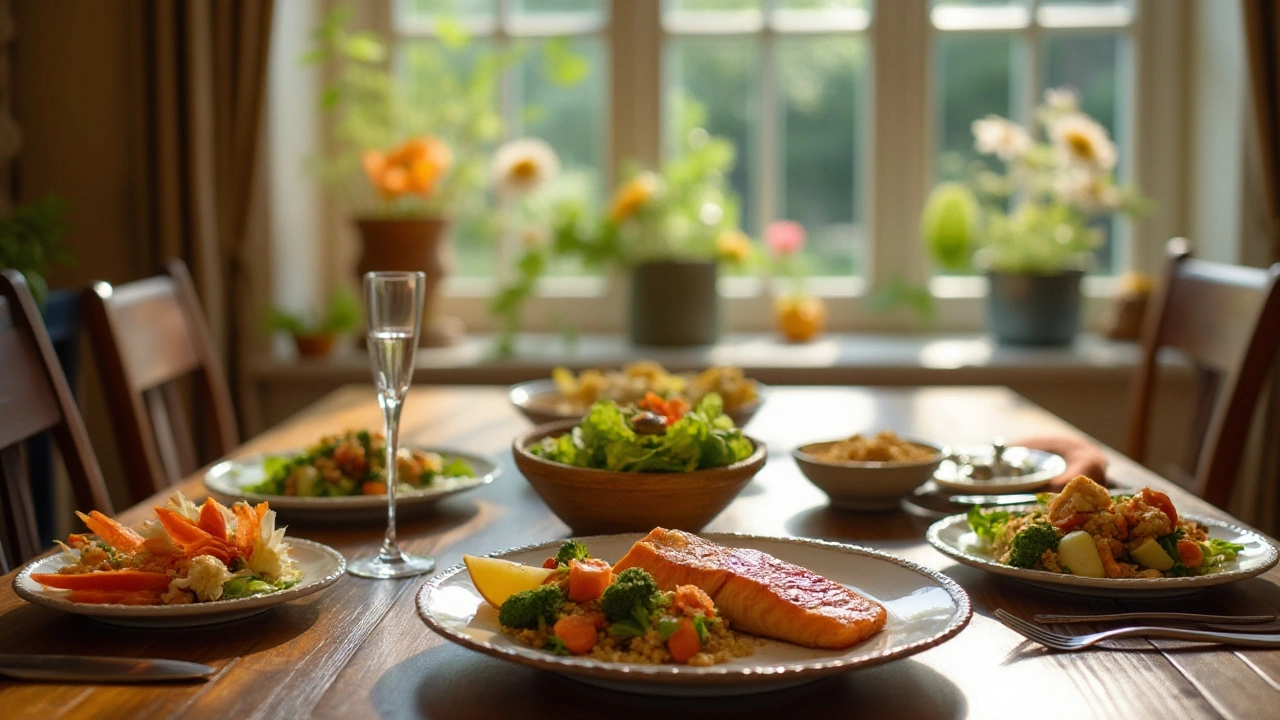When it comes to having a healthy dinner, it's more than just about counting calories or sticking to a rigid plan. It's about nourishing your body with the right balance of ingredients that promote well-being. The meal should consist of a delightful mix of flavors and nutrients that leave you feeling satisfied and energized.
While every culture and kitchen has its own take on what constitutes a perfect meal, sticking to a few core principles can steer you in the right direction. Whether you're a seasoned chef or just trying to figure out what to cook after a long day, understanding these basic components will help you breathe new life into your dinner routine.
- Understanding the Components of a Healthy Dinner
- Exploring Plant-Based Dinner Options
- Incorporating Lean Proteins for Balance
- Sneaky Ways to Add More Vegetables
Understanding the Components of a Healthy Dinner
Creating a healthy dinner starts with understanding the essential building blocks of a nutritious meal. At its core, a balanced dinner should incorporate a blend of macronutrients: carbohydrates, proteins, and fats. These elements work together harmoniously to support bodily functions, fuel energy needs, and promote a sense of fullness and satisfaction. Carbohydrates, often misunderstood, serve as a primary energy source. Opting for complex carbohydrates like whole grains, quinoa, or sweet potatoes provides a slow-release energy boost. Whole grains have the added benefit of containing dietary fiber, crucial for digestive health, and keeping you satiated longer.
Equally important are proteins which play a vital role in rebuilding and repairing tissues. Including a moderate portion of lean proteins such as chicken, turkey, tofu, or legumes can provide necessary amino acids without excess saturated fat. Proteins are not just important for muscle repair; they are also essential for producing enzymes and hormones within the body. Contrary to popular belief, not all fats are detrimental. Healthy unsaturated fats found in avocados, nuts, and olive oil are beneficial for heart health and should be a regular feature in any diet. These fats support cellular function and improve the absorption of fat-soluble vitamins, ensuring we get the most out of the veggies we consume.
A significant component of any healthy dinner is a vibrant array of vegetables. They infuse the meal with vitamins, minerals, and antioxidants, which play a role in reducing inflammation and lowering the risk of chronic diseases. Veggies come in diverse colors, each with unique phytonutrients. Making your plate as colorful as a rainbow is a simple trick to maximize your nutrient intake. As Dr. Michael Greger reportedly notes, "Eating a variety of foods ensures you're covering all nutritional bases." Consuming different vegetables also keeps meals exciting and diverse, preventing any monotony in your culinary adventures.
Hydration is an often overlooked but vital component of a nutritious meal. Ensuring you have a glass of water at dinner can aid digestion and keep your body systems functioning optimally. While dinners may often come with the temptation of sugary drinks or potentially dehydrating alcohol, integrating water or herbal teas supports bodily needs without unnecessary additives. Cooking methods matter, too. Steaming, grilling, or baking your food keeps the nutrients intact better than frying or boiling, which might deplete them. Serving sizes matter just as much - portion control can prevent overloading your system during the evening hours.

Exploring Plant-Based Dinner Options
Plant-based diets have become a popular choice for many people looking to improve their health and reduce their environmental footprint. Embracing a diet centered around fruits, vegetables, whole grains, legumes, nuts, and seeds doesn't mean you have to part with delectable flavors or satisfying dishes. On the contrary, the world of plant-based dinners is abundant with creative and nutritious possibilities that can satisfy even the most discerning palate. For those venturing into this space, there are an endless array of recipes and ideas that not only bring vibrancy and color to your plate but also leave you feeling nourished.
One of the primary appeals of a plant-based diet is the rich variety it offers. Whether you decide to recreate classics like a hearty vegetable stir-fry or venture into more exotic territories with dishes like jackfruit tacos, the options are virtually limitless. Nutritious meals often feature colorful vegetables rich in antioxidants, beans, or lentils high in fiber and protein, and delicious herbs and spices that elevate the flavor profile of your dinner. Aiming to fill half your plate with various vegetables can introduce a plethora of vitamins and minerals essential for maintaining good health. This diversity also means you're less likely to tire of the same old foods as each meal can be an exploration of new tastes and textures.
"Eating a variety of colorful fruits and vegetables provides a wide range of phytonutrients that work together to promote health," says Dr. Michael Greger, a renowned nutrition expert.
Protein is another essential component often associated with meat-heavy dishes, yet plant-based options are equally capable of delivering sufficient protein through foods like beans, lentils, tofu, and quinoa. A common misconception is that protein cannot sufficiently be sourced through plants, but numerous studies have debunked this myth. Research indicates that a diet rich in plant-based proteins can actually support cardiovascular health and aid in weight management. The key is to mix and match different sources to ensure you're obtaining a complete amino acid profile.
Practical Tips for Incorporating More Plants
Shifting to a plant-based diet doesn't need to be an overnight change. Start by gradually incorporating more healthy dinner recipes that emphasize plant sources. Experiment with meatless Mondays or try swapping out meat for plant proteins in your favorite recipes. Every step you take towards including more plants can contribute to a healthier holistic approach to eating. Being open to new ideas and foods opens doors to a rewarding culinary journey that benefits your health, the animals, and the environment.
| Food | Protein Content (per cup cooked) |
|---|---|
| Quinoa | 8 grams |
| Lentils | 18 grams |
| Chickpeas | 15 grams |
| Tofu | 20 grams |
Exploring a plant-based diet offers endless possibilities for culinary creativity while providing numerous health benefits. With so many vibrant and diverse foods at your disposal, every meal can become an adventure in taste and nutrition that makes the journey toward a healthier lifestyle an enjoyable and fulfilling endeavor.

Incorporating Lean Proteins for Balance
Embracing **lean proteins** is an essential step in crafting a dinner that truly nourishes the body. These protein sources are not only lower in fat but also packed with vital nutrients the body craves. Think of options like skinless chicken breast, turkey, fish such as salmon or halibut, and plant-based proteins including tofu and quinoa. Each of these presents its own unique profile of nutrients along with a satisfying dose of protein. Including a variety of these sources throughout the week can help maintain muscle mass, which is especially crucial as we age.
Incorporating lean proteins into dinner doesn't have to be monotonous or routine. How you prepare these proteins can vary widely and add an exciting element to your meals. For instance, baking or grilling lean meats with a medley of spices can create exquisite flavors with minimal added oils or fats. Marinades are also a fantastic way to introduce hints of exotic tastes. Teriyaki-marinated grilled chicken, herbed baked fish, or even spiced quinoa patties are just a few examples of how you can turn lean proteins into star dishes without increasing calorie content unnecessarily.
"The emphasis on lean proteins isn't just a trend; it's a fundamental approach to balanced eating," notes Dr. Kim Edwards, a well-regarded nutritionist. "Reducing saturated fat intake while ensuring adequate protein helps support a healthier heart and muscle function."
Considering that both plant-based and animal sources count as lean proteins, there are endless combinations to explore. Incorporating legumes like lentils and chickpeas can also add depth and complexity to your dishes. When paired with vegetables or whole grains, these proteins can help form complete meals that are both balanced and satisfying. Legumes are particularly rich in protein and fiber, providing essential nutrients that aid in digestion and keep one full until the next meal.
And let's not forget about the importance of portion control when it comes to **healthy dinner** options. While it's important to get enough protein, it's equally crucial to balance it with other macronutrients to form a complete meal. A visual guide such as a balanced plate can be instrumental in ensuring portions are appropriate. Aim to fill half your plate with non-starchy vegetables, one-quarter with protein, and the remaining quarter with whole grains. This method not only aids in portion control but it's also a straightforward way to maintain a balanced diet. For those tracking their intake, utilizing a nutrition app can provide critical insights into macronutrient breakdowns and support informed choices.
Lastly, as diverse as our taste buds are, experimenting with different cooking methods and combinations can be a fun and rewarding experience. The world of lean proteins offers a canvas upon which you can express your culinary creativity. Whether it’s embracing the simplicity of grilled chicken and roasted vegetables or venturing into the exotic with spiced tofu and vegetable stir-fries, each meal is a chance to nourish your body and delight your senses. Remember, a balanced meal is the foundation of a healthy life, so make every dinner an opportunity to embrace those healthier choices.

Sneaky Ways to Add More Vegetables
Adding more vegetables into your meals doesn't mean you have to compromise on taste or style. In fact, there are numerous creative methods to incorporate these nutrient-packed foods into your diet without even noticing them. One effective technique is to blend vegetables into sauces and soups. By pureeing veggies like carrots, spinach, or squash into a tomato sauce or curry, you not only enhance the dish's flavor but also boost its nutritional value without much effort. The silky smoothness that pureed veggies add can be quite delightful, and they blend seamlessly with the spices and other ingredients.
Another stealthy tactic is using vegetables as substitutes for ingredients you might traditionally use. Consider swapping out regular pasta for zucchini noodles or spaghetti squash. This alters the texture in a pleasing way while reducing the caloric intake significantly. Cauliflower is another versatile veggie that can replace grains and starches. Mashed cauliflower can be a delicious low-carb alternative to mashed potatoes, and cauliflower rice is an excellent substitute for white or brown rice, full of vitamins C, K, and B6.
Baking with vegetables is another delicious way to sneak them into your diet. Adding shredded zucchini or carrot to muffins, breads, or cakes can enhance moisture and add a subtle sweetness that pairs wonderfully with spices like cinnamon and nutmeg. Don't forget about the magical avocado, which can be used to replace butter in many recipes, allowing you to enjoy rich, creamy desserts with a dose of healthy fats.
According to the USDA, adults should aim for at least nine servings of fruits and vegetables per day, but many find this challenging. By implementing these simple strategies, you can effortlessly meet that goal while delighting your taste buds.
Grilled or roasted vegetables can also transform your meal. Tossing an array of veggies such as bell peppers, broccoli, and asparagus in olive oil and seasoning them with your favorite herbs makes a delicious addition to any meal. Investing in skewers can make grilling veggies fun, and the slight char adds a depth of flavor that might even convert the staunchest of veggie skeptics. Herbs like rosemary, thyme, or cilantro can infuse your vegetables with irresistible aromas and flavors.
Lastly, consider snacking on veggies more often. Stack your fridge with ready-to-eat options like celery, cucumber slices, and cherry tomatoes, accompanied by a creamy hummus or guacamole dip. The crisp, refreshing taste of raw veggies paired with a flavorful dip makes for a satisfying snack that can curb hunger and deliver nutrients on the go. With these tips and a bit of creativity, adding vegetables into your daily dinner routine can be an enjoyable and rewarding endeavor.





